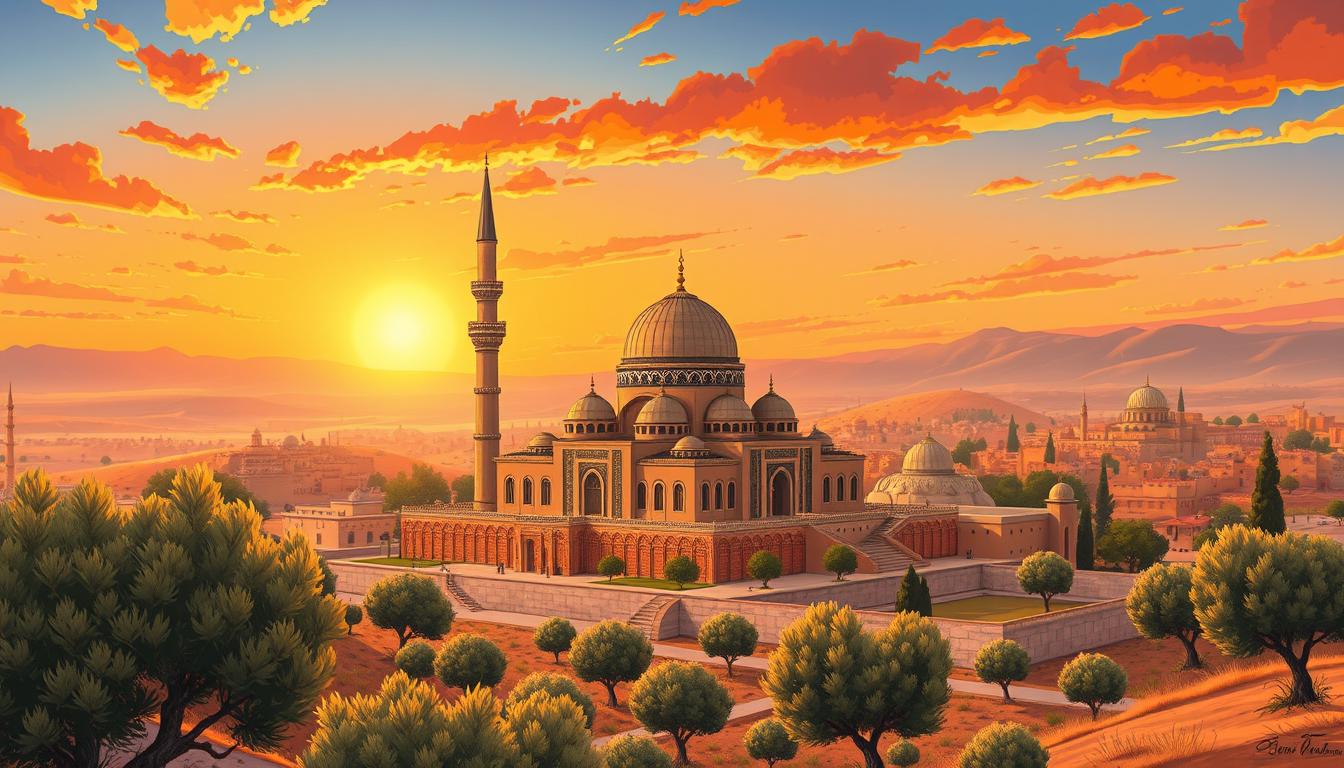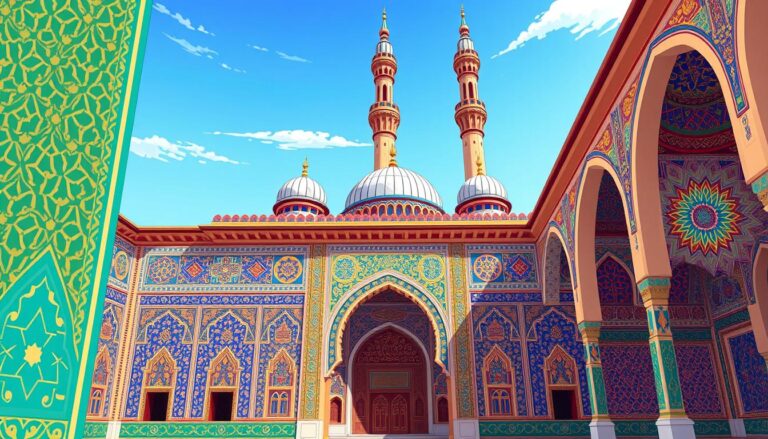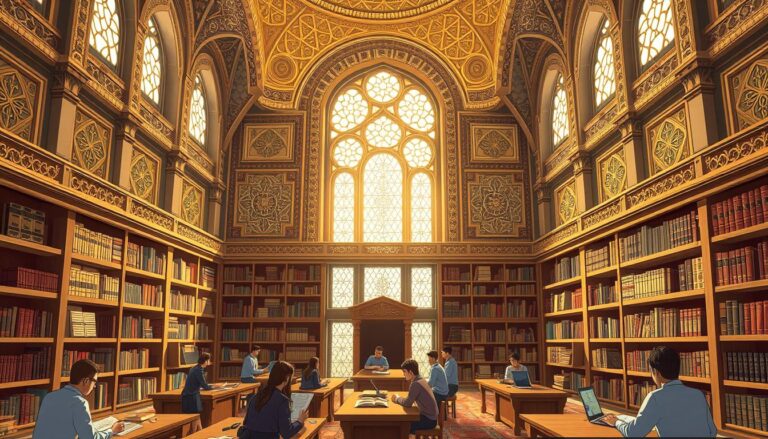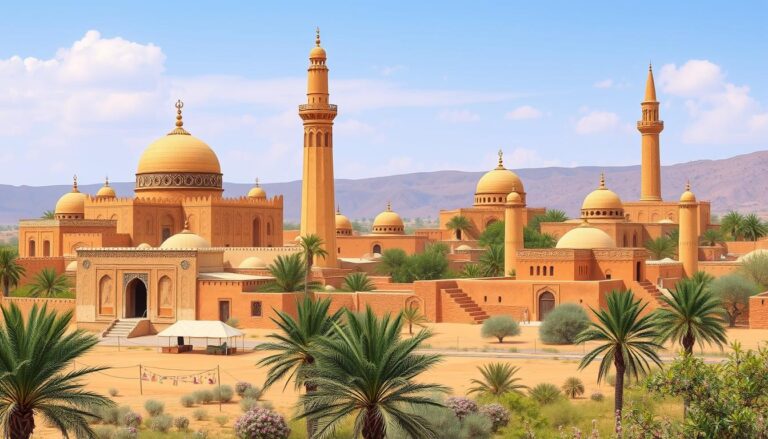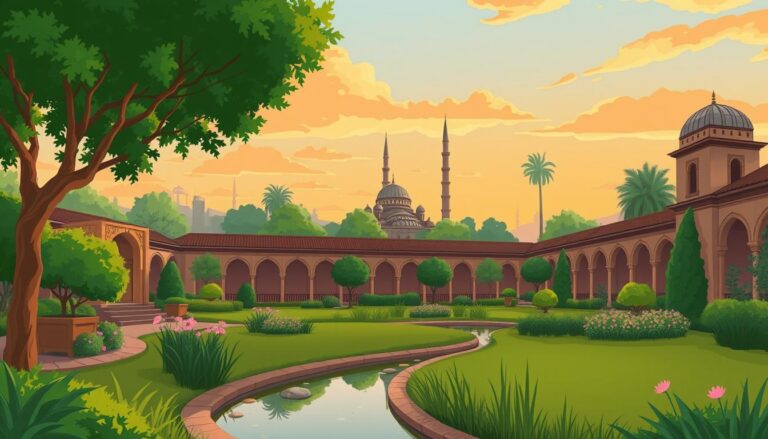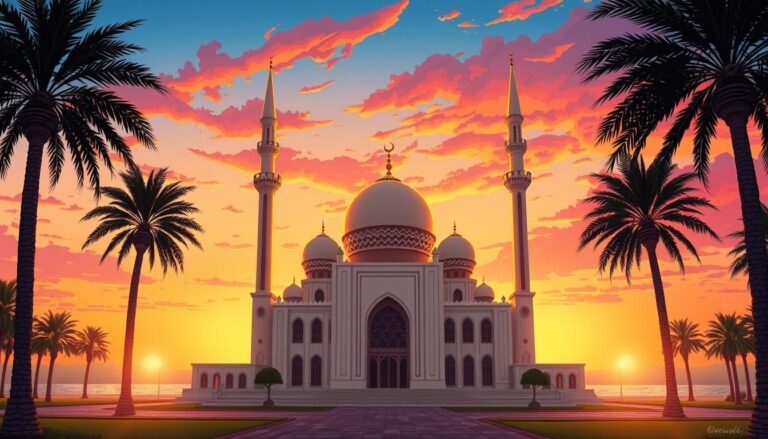Islam in Syria
Islam is the main religion in Syria, with more than 90% of people calling themselves Muslim. The country has many Islamic groups, like Sunni, Shia, and Sufi. Syria’s Islamic history started in the 7th century when Muslim Arabs conquered the area.
The Umayyad and Abbasid caliphates in Damascus and Baghdad shaped Syria’s past. Today, Islam is still a big part of Syrian life. It affects the society, politics, and daily routines.
Historical Background of Islam in Syria
Before the 7th century CE, Syria was a heartland of Eastern Orthodox Christianity. It was the main religion of the Byzantine Empire. In 634 CE, Muslim Arab armies led by Khalid ibn al-Walid conquered the region. This started the Islamization of Syria.
Over the next decades, most people in Syria turned to Islam. The Aramaic-speaking people mainly adopted Arabic language and culture.
Conquest and Islamization of Syria
The Muslim Conquest of the Levant was a key event in Syria’s history. Arab armies moved north from the Arabian Peninsula. They defeated the Byzantine forces and took control of the area.
This led to the Islamization of the population. The local people started to follow the new faith.
Umayyad and Abbasid Rule in Syria
From 661 to 750 CE, Syria was ruled by the Umayyad Caliphate. They made Damascus their capital and used local Arab tribes for military power. After the Umayyads fell, Syria became a province of the Abbasid Caliphate. They ruled until the 10th century CE.
“The Umayyad Dynasty was the first great Islamic dynasty to rule from Damascus. Their time marked a key period in the Islamization of Syria.”
Sunni Islam in Syria
Sunni Islam is the main religion in Syria, with about 74% of the people following it. The Sunni community in Syria is split into two main groups: the Arab Sunnis and the Kurdish Sunnis.
Arab Sunni Muslims
The majority of Sunni Muslims in Syria speak Arabic. They have a long history and rich culture. These Arab Sunnis are found in many jobs, social groups, and political parties. They play a big role in Syria’s society and politics.
Kurdish Sunni Muslims
There’s also a big group of Sunni Kurds in Syria, the second-largest ethnic group. They follow the Hanafi and Shafi’i schools of Islamic law. They are a key part of the Sunni Muslim majority in Syria.
Sunni Muslims in Syria have faced many challenges, especially during conflicts and political instability. The Syrian civil war, for example, has hit Sunni Arab communities hard. They have suffered a lot of casualties and persecution. Yet, the Sunni Muslim community in Syria remains strong and influential in the country’s society and religion.
“The Sunni Muslim community in Syria is a diverse and resilient group, with a rich cultural heritage and a strong presence across various sectors of society.”
Shia Islam in Syria
In Syria, Sunni Islam is the main form of Islam. But, there are also Shia Muslim minorities. The Alawites are the largest group, making up about 11% of the population. They live mainly in western Syria’s coastal areas.
The Alawites have their own unique beliefs and practices. These are different from what most Shia Muslims believe.
Alawite Muslims
The Alawite community has a long and complex history in Syria. In the 19th and 20th centuries, Syrian Shi’a Muslims were marginalized among the pan-Arab nationalists. But, in the 1950s, Najafi scholars started the Jafari Society in Latakia. Their goal was to educate the Alawis and get the government to recognize Twelver Shi’ism.
In the 1970s, many Shi’a students moved to Damascus’s Sayyida Zaynab suburb. They built a strong community and educational centers. This area became a key place for learning and pilgrimage, with help from Iran.
Ismaili Muslims
The Ismailis are another Shia group in Syria. They are the second-largest Shia community. They mostly live in Hama and Tartus.
The Twelvers are the smallest Shia group, making up about 0.5% of the population. They mainly live in Damascus and Aleppo.
The Shia Muslim minorities in Syria have faced many challenges. Yet, they have greatly influenced the country’s religious and cultural scene. As Syria’s conflict continues, the role of these Shia communities is crucial to understanding the country’s complex religious dynamics.
Syrian Islamic Culture
Syria’s Islamic heritage has deeply influenced its culture. It shapes art, architecture, social norms, and daily life. The Islamic Culture in Syria shows the lasting impact of this faith.
The country’s many Syrian Islamic Traditions are seen in its beautiful mosques and shrines. These sites, like the Umayyad Mosque in Damascus, are not just for worship. They also highlight the artistic and cultural achievements of Syria’s Muslim communities.
The Islamic Influence on Syrian Society goes beyond religious buildings. It touches every part of Syrian culture. Islamic beliefs have shaped the country’s food, music, literature, and art, creating a rich cultural heritage.
Islamic values have also shaped Syrian social structures and gender roles. They have influenced the country’s political institutions, forming its cultural identity.
“The Islamic heritage of Syria is not just a relic of the past, but a living, breathing part of the country’s cultural fabric, constantly evolving and shaping the lives of its people.”
As Syria faces today’s challenges, its Islamic Culture in Syria remains a source of strength. It reminds us of the lasting power of faith and tradition in shaping human history.
Islam in Syria
Syria is a country with a mix of religions, but Islam is the main one, making up over 90% of the people. The Muslim community in Syria includes Sunni, Shia, and Sufi groups. There are also smaller groups like the Alawites and Ismailis.
The Sunni Muslims are the biggest part of Syria’s Muslim population, about 74%. The other 16% are Shia Muslims, with the Alawites making up 11% and Ismailis about 1.5%.
Aside from Muslims, Syria also has Christians and Druze, making up about 10% of the population.
The religious scene in Syria has been influenced by history, politics, and regional factors. The Ba’th regime has shaped the country’s religious landscape. At times, it promoted Arabism over Islamic identity.
But lately, the Syrian regime has shown more openness to religious views. It has allowed Islamist groups to join politics and work with the government. This move aims to boost the country’s influence and stability.
“The religious landscape in Syria has been shaped by historical events, political developments, and regional dynamics.”
Islamic Institutions in Syria
Syria is home to many Islamic institutions that are key to its culture and faith. These include mosques, known for their beauty and history. They are important for worship and learning about Islam.
Mosques and Religious Sites
In Syria, you’ll find famous mosques like the Umayyad Mosque in Damascus. Also, the Great Mosque of Aleppo and the Nabi Habeel Mosque in Homs are notable. These mosques are not just places of prayer but also centers of Islamic knowledge.
Islamic Education in Syria
Syria also has other important Islamic places, like shrines and madrasas (Islamic schools). These places are vital for education, spirituality, and community. They help keep the faith alive in Syrian society.
The Fatah Islamic Institute is a great example. It was started in 1956 by Sheikh Saleh al-Farfour. It changed over time and became the University of the Levant for Islamic Sciences in 2017. This shows how the Syrian state and religious leaders work together.
Even with the ongoing conflict, these institutions are crucial. They help keep Syria’s rich faith and culture alive. They are lights of hope, education, and community in hard times.
Islamic Teachings and Beliefs in Syria
Islamic teachings deeply shape Syrian society. They influence personal behavior and legal systems. The Hanafi and Shafi’i schools are key. They guide how Sharia law in Syria is applied in daily life.
The Syrian government has tried to keep some areas secular. Yet, Islamic principles and values remain crucial. They influence the country’s culture, architecture, art, and literature.
About 60% of Syrians are Sunni Muslims. The Alawites, a Shia branch, make up around 11.5% of the population. Ismailis and Twelvers also live in Syria, though in smaller numbers.
Despite differences in Islamic Jurisprudence, Syrians share core beliefs. They believe in one God (Allah) and the importance of prayer. They also value charitable giving and social justice.
“Islam is not just a religion, it is a way of life. It shapes the very fabric of Syrian society, from the way we conduct our personal affairs to the way we govern our nation.”
Syrian Islamic History
Syria’s history of Islam began in the 7th century CE. Muslim Arab armies conquered the region then. Many prominent Islamic figures and Islamic scholars have lived here. They’ve greatly influenced Islamic thought and practice.
Important historical figures from Syria include Khalid ibn al-Walid and Mu’awiyah I. Also, the famous Sufi mystic and poet Ibn Arabi. Syria has also given rise to many Islamic jurists, theologians, and scholars. Their work has shaped the Muslim world’s intellectual and spiritual traditions.
Prominent Islamic Figures and Scholars
- Khalid ibn al-Walid – An early Islamic military commander known for his strategic brilliance and decisive victories.
- Mu’awiyah I – The first Umayyad caliph, who played a pivotal role in the early Islamic empire.
- Ibn Arabi – A renowned Sufi mystic and poet whose writings have had a profound influence on Islamic spirituality.
- Al-Jazari – A renowned Islamic scholar and inventor who made significant contributions to the fields of engineering and mathematics.
- Saladin – The famous Muslim ruler who led the Ayyubid dynasty and played a key role in the Crusades.
“Syria has long been a cradle of Islamic civilization, producing some of the most influential thinkers and leaders in the history of the Muslim world.”
These are just a few examples of Syria’s many Islamic scholars and historical figures. Their legacies continue to influence the region and beyond.
Islamic Practices in Syria
In Syria, Islam is a rich mix of traditions and customs. These have grown over many years. Syrian Muslims celebrate many festivals that show their strong Islamic identity.
Celebrations and Festivals
Important Islamic celebrations in Syria include Eid al-Fitr, Eid al-Adha, and the Prophet Muhammad’s birth (Mawlid). These times are filled with prayer, feasting, and cultural activities. They unite the community.
Eid al-Fitr is a joyous time after Ramadan. Families come together for meals, gifts, and visits. Children often get new clothes and sweets.
- Eid al-Adha, or the “Feast of Sacrifice,” honors the Prophet Ibrahim’s sacrifice. It’s celebrated with animal slaughter, meat for the poor, and community gatherings.
- The Mawlid celebrates the Prophet Muhammad’s birth. It features poetry, Quran readings, and special meals with family and neighbors.
Many Syrians also take part in Sufi rituals and ceremonies. These spiritual practices, like dhikr and visiting Sufi shrines, are important in Syrian culture and religion.
“The practice of Islam in Syria is a tapestry of traditions and customs that have evolved over centuries, reflecting the deep-rooted Islamic identity of the Syrian people.”
Conclusion
Islam has been a key part of Syrian identity and culture for over a thousand years. It has deeply influenced the country’s history, society, and daily life. From the Arab conquest in the 7th century to today’s diverse Islamic practices, Islam’s mark on Syria is clear.
Despite Syria’s recent challenges, Islam remains a core part of most citizens’ lives. The country’s future will likely see Islam’s lasting influence on its identity and culture. Sunni, Shia, and other Muslim communities have kept their traditions alive, even through hard times.
This shows Islam’s strong presence in Syria. It’s a testament to the faith’s ability to adapt and endure.
In summary, the Conclusion of this exploration of Islam in Syria shows its deep impact on the nation. As Syria moves forward, Islam’s role in people’s lives will continue to shape its path.
Source Links
- Localism, War, and the Fragmentation of Sunni Islam in Syria
- Syria: Old-timers and Newcomers
- Syria – United States Department of State
- Syria – Umayyad Dynasty, Damascus, Middle East
- The Birth of Islam | Essay | The Metropolitan Museum of Art | Heilbrunn Timeline of Art History
- Overview of Religious History of Syria | EWTN
- 2.11.1. Sunni Arabs
- Syria’s “Sunni Question” Is Here to Stay
- Islam in Syrian Textbooks: Monolithic and Nonpluralistic
- Shi’ism in Syria
- Iran Is Trying to Convert Syria to Shiism
- Syria
- Religion and the law in Syria
- Middle East Brief 77
- Islam in Syria
- Religion in Syria
- Hafiz al-Asad Discovers Islam
- Syria’s Regime Has Given the Fatah Islamic Institute Influence, but at What Cost?
- Religious institution in Syria: Al-Assad’s old-new target – Enab Baladi
- Syrian refugees: Syria: Land of history, civilizations and war
- Islamic Revival in Syria Is Led by Women
- Alawites and the Fate of Syria
- Syrian – Religion
- Islamic Education in Syria
- Sufism in Syria
- The Role of Religion in the Political Future of Syria: State Muslimness versus Islamism
- Syria – United States Department of State

